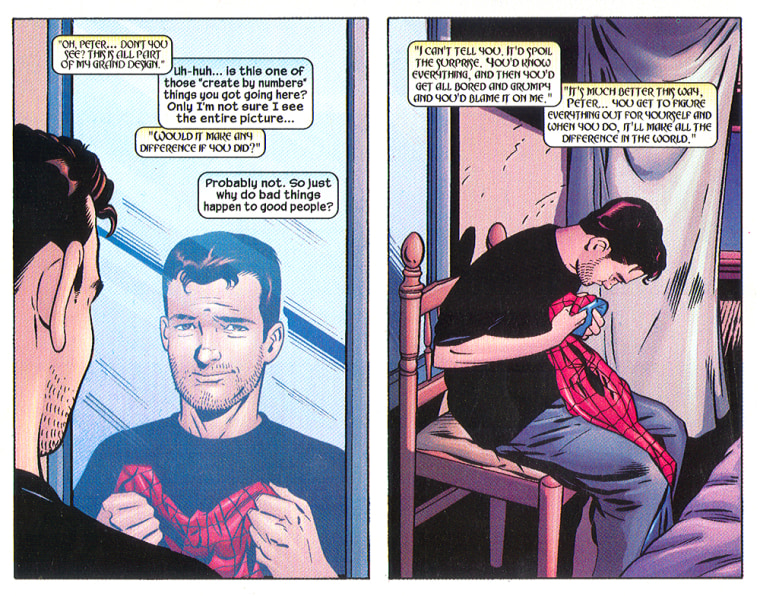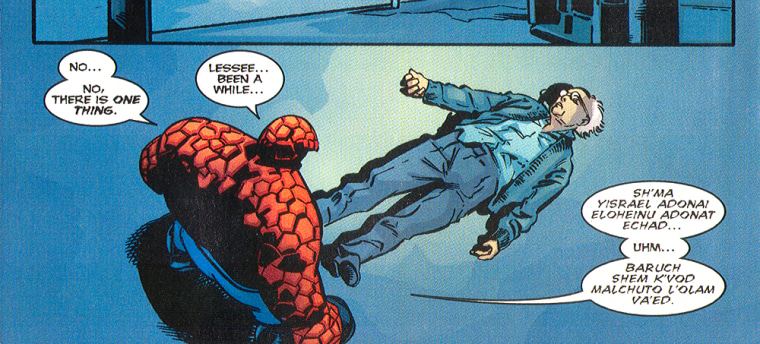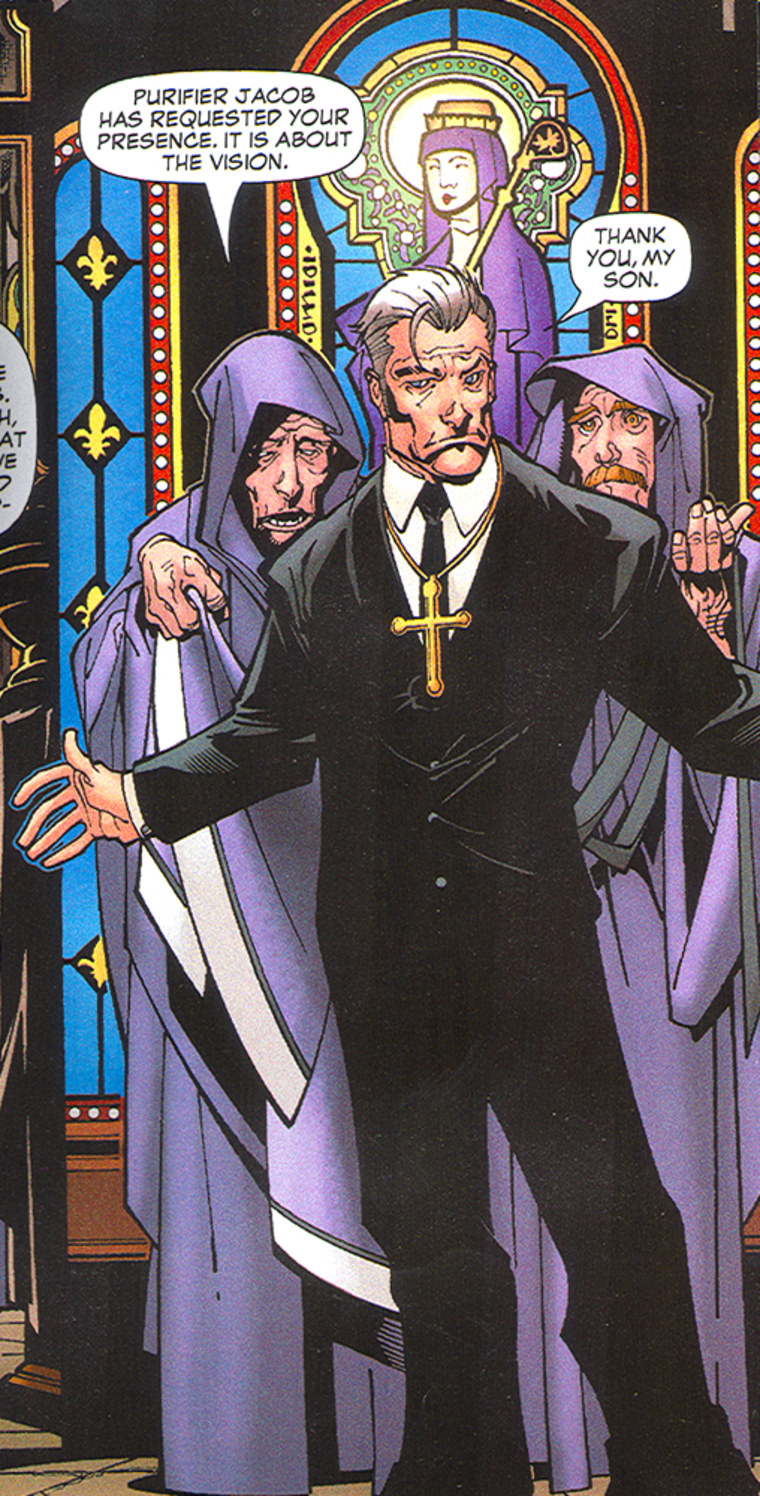And the Lord said:
“OH, PETER ... DON’T YOU SEE? THIS IS ALL PART OF MY GRAND DESIGN.”
(Here, the Lord always speaks in CAPITAL LETTERS.)
Here, God is speaking to Peter Parker.
He is speaking to Spider-Man.
Peter Parker, Protestant
Throughout the history of Marvel Comics’ “Spider-Man” franchise, little clues have been dropped that Peter Parker is a believer (specifically, a Protestant, although what denomination isn’t clear). There’s the “God Bless Our Home” stitching on the kitchen wall, for example, and then there was the night he thanked God for bringing Mary Jane into his life.

Critics have long found Christian themes in Peter Parker’s struggle to determine what’s right. “With great power comes great responsibility” may be a watchword of the recent Spider-Man movies, but it’s lifted straight from the comic books.
Comic books from edgier alternative publishers and adult-oriented graphic novels have explored explicitly religious ideas for several decades, but what’s striking is how often such themes have been appearing lately in the most mainstream of publications. For a character you can’t even see, God does seem to pop up all over the place in the comic book universe.
Or doesn’t. One of the more talked-about comic book debuts in recent years was the introduction last year of Antoine Sharpe, a government agent who rejects all things supernatural, by Desperado Publishing and Image Comics.
Sharpe’s rigid devotion to rationalism (“If your God falls out of Heaven tomorrow I’ll walk up, shake his hand, tug his beard, ask him who shot JFK, and then I’ll know God. Until then, he does not exist.”) provides his nickname around the office — and the name of the series: “The Atheist.”
‘Ultimate questions of good versus evil’
Using comic books as a popular medium to pass on ethical, even religious, values is nothing new, said Christopher Sharrett, a professor of communication and film studies at Seton Hall University in South Orange, N.J. What’s different is the serious, usually non-judgmental examination of core Judeo-Christian themes in mature stories.
Sharrett, who has written widely about both comic book literature and religion, traces the modern exploration of religion to the 1980s, “where various talented writers like Alan Moore [“Watchman,” “V for Vendetta”], Frank Miller [“Sin City,” the revival of Batman as the Dark Knight], Art Spiegelman [“Maus”] and many others showed that you could make the medium respectable and take on these moral and political issues without denigrating them.”
“With comics,” said Greg Garrett, the author of “Holy Superheroes! Exploring Faith & Spirituality in Comic Books,” “the fact that we’re dealing with ultimate questions of good versus evil — all of those things that we wrestle with in theology — it makes it a natural place for those to be part of any important story.”

Those ultimate questions are being asked in unexpected places. Four years ago, we learned that The Thing is Jewish when he was shown praying in Hebrew over the body of a friend he had sought to protect. (“It’s just ... you don’t look Jewish,” a surprised character tells the enormous, destructive orange rock-man, who explains to another character that he never said anything about it because he didn’t want to embarrass other Jews, seeing as he was, after all, an enormous, destructive orange rock-man.)
Reading the roll
You can track who’s what by diving into a database at ComicBookReligion.com, a project of the exhaustive religion reference site Adherents.com. The database links to closely argued, heavily referenced essays that, for the most part, build compelling cases for its identification of a particular character’s church ways.
Some, like Catholic Girl, are pretty obvious and are noted with a link to a simple character description. But if you’re a big-time superhero, you get the full treatment. The Hulk’s lapsed Catholicism is established in an original essay running more than 3,500 words, with footnotes to scholarly papers on psychiatry and philosophy, supported by copious panels reprinted from the comic book series.
(Superman, for the record, is probably Methodist, while Batman is most likely a lapsed Catholic or Episcopalian.)
That sort of detective work can be fascinating (and a great time-waster), but it doesn’t really capture what’s going on under the surface: the commonplace acceptance in the rebellious world of comic books of faith and the exploration of the divine.
It’s a development that mirrors recent trends in American society, Garrett said.
“In America today, where we’re told that 90-some percent of people believe in God and a certain large percentage of people have an active life of faith — being involved in church or praying or some other practice — then I think it’s going to be unrealistic not to see that depicted in a story,” said Garrett, a professor of English at Baylor University in Waco, Texas.
“Comics for the last 20 years have [come to] understand that it’s not just teenage boys who are reading about guys in capes,” he said. “There are actually some serious stories that are being told — universal stories.”
The transfiguration of Rev. Stryker
That reflection isn’t always positive. Just as there are preachers on the wrong side of the law in real life, so, too, are there some seriously whacked-out church folk in the graphic universe.

Perhaps the most recognizably true-to-life character is the Rev. William Stryker, an evangelical preacher whose mission is to wipe the mutants of the X-Men universe from the face of the Earth.
Twenty years ago, when Stryker was introduced, “he was someone who represented intolerance,” Garrett said. “There are other ways that we could represent it — you could have picked a white supremacist — but what brings the extra tang to the story is the disconnect between the message of love that’s supposed to be the Christian message and the message of exclusion that is sometimes the message that Christian churches put forth.”
It made perfect sense for the time, said Sharrett, of Seton Hall. Stryker was born during the 1980s, during the liberal backlash against the ascendance of the Religious Right, and that was no accident.
“That kind of device — that explicitly religious idea — you would find this in conservative moments of American history. Rather mainstream superhero comics with religious ideas speak to the conservatism of the time and the popularity of other religious narratives,” he said, naming the apocalyptic Left Behind novels and the television show “Revelations,” in which a scientist and a nun uncover evidence that the world is approaching the End Days.
Interestingly enough, the producers of the 2000 movie “X-Men” turned Stryker into a colonel in charge of a government bureaucracy. In that way, they managed to sidestep complaints that have occasionally been lodged against the character in the comic book series, which some conservative and religious scholars have denounced as a totem of religious hatred.
The conversion of ‘The Atheist’
To a certain extent, the same thing has happened to “The Atheist.” When issues 4 and 5 appear, probably later this year, the title will have been de-emphasized, and it will eventually be branded exclusively as “Antoine Sharpe,” said Phil Hester, the series’ creator and writer.
Because of the series’ title and Hester’s reputation as an illustrator (he is perhaps best known for artistically invigorating the mainstream characters Green Arrow and Swamp Thing), “The Atheist” generated buzz even before the first issue was released last year. From the beginning, television and the movies were intrigued, but the TV talks fizzled, Hester said.
“The TV people were like, ‘Look, there’s not going to be any sort of “The Atheist” brought to you by Ford,’” he said from his home in Iowa. “‘I don’t think we’re going to be able to round up sponsors with this title.’”
That wasn’t a problem for Hester, who was already rethinking the title. For one thing, the story line isn’t religious, and “The Atheist” raised expectations among readers that Hester wasn’t prepared to fulfill. In effect, the title had become bigger than the story.
“I think people were expecting bigger answers,” he said. “And I just thought it was a cool name. I just wanted to present this character with an impenetrably skeptical, logical world view and throw him into these unexplainable paranormal events.”
More striking were the letters Hester got, most of them positive. But a few “sort of got to me,” he said. They were from teens who were “taking a lot of grief in their school life for their world view.”
“They didn’t care so much about the book being reflective of their world view, but they thought the fact that any horror comic book that had that title sort of reinforced some negative stereotypes about their world view,” Hester said. “And after thinking about it, I could not argue with that point. I agreed.”
Hester said the running conversation drove home to him that “we’re all individuals.” In his letters, “no two people had the same understanding of what being a Baptist was like, and no two other people had an understanding of what being an atheist was like. All these belief systems were unique to each individual.
“That’s sort of the way we as creators are like,” he added. “We're doing the best we can to express ourselves. We’re not always going to represent your point of view.”
The positive thing, he said, is that the topic can be discussed rationally today. While he probably won’t do so with “Antoine Sharpe,” Hester said he wouldn’t hesitate to take on an explicitly religious story some other time: “I don’t want to be bound by what my comic can and can’t do. If I want to explore it, it will go in that direction.”
Today, “creators feel they have that freedom,” he said. “Whether or not they’re using it in an effective way is another issue, but at least creators feel like they can explore all these issues.”
